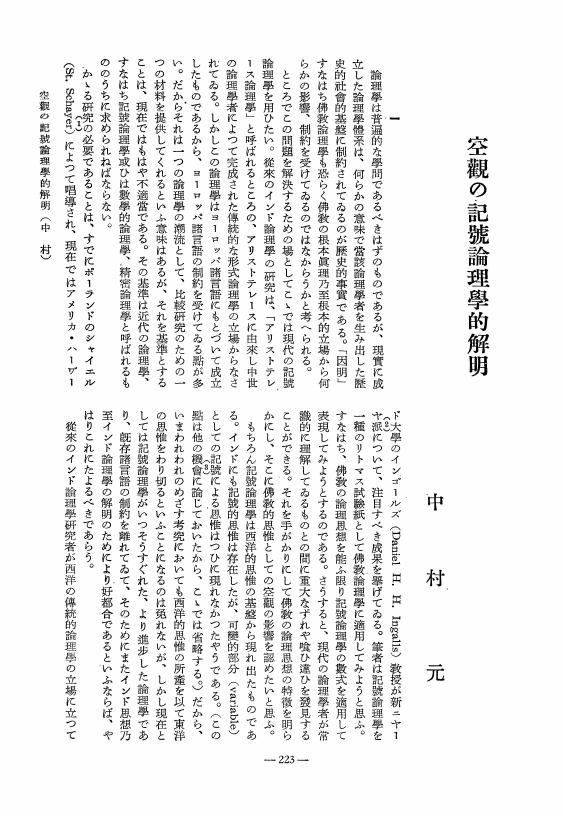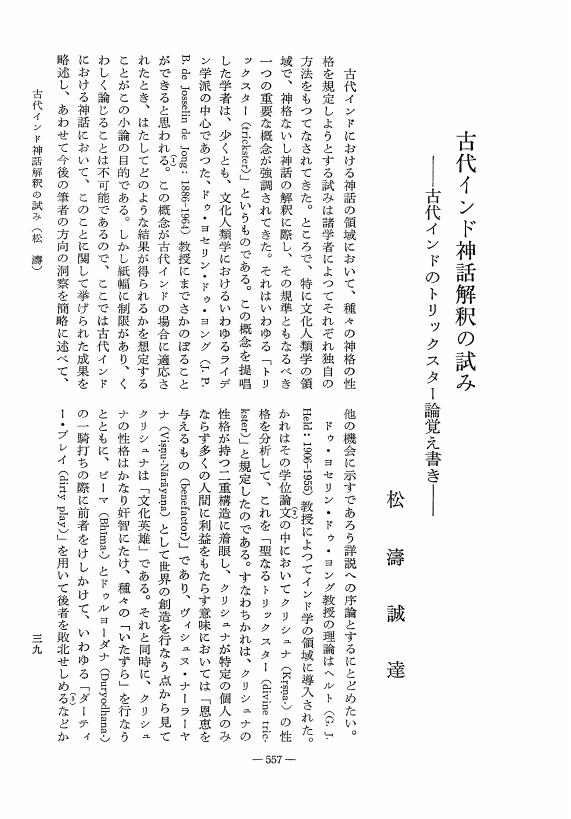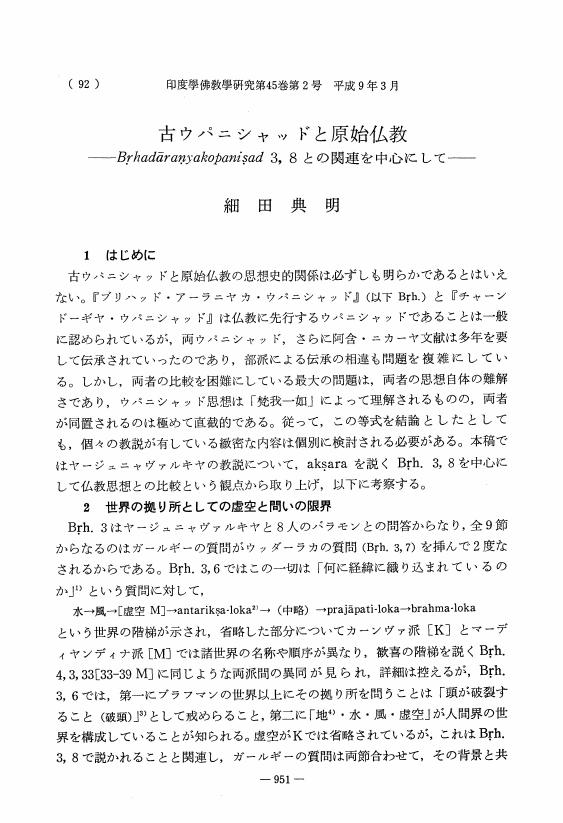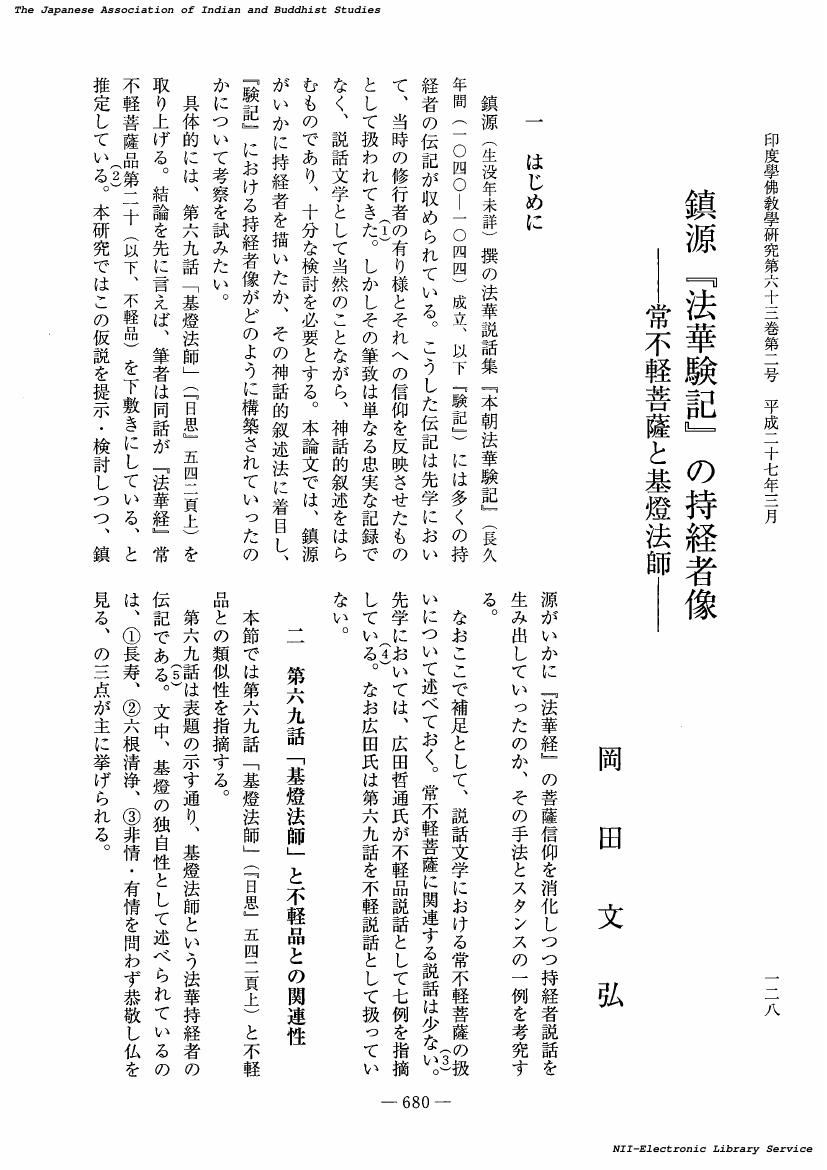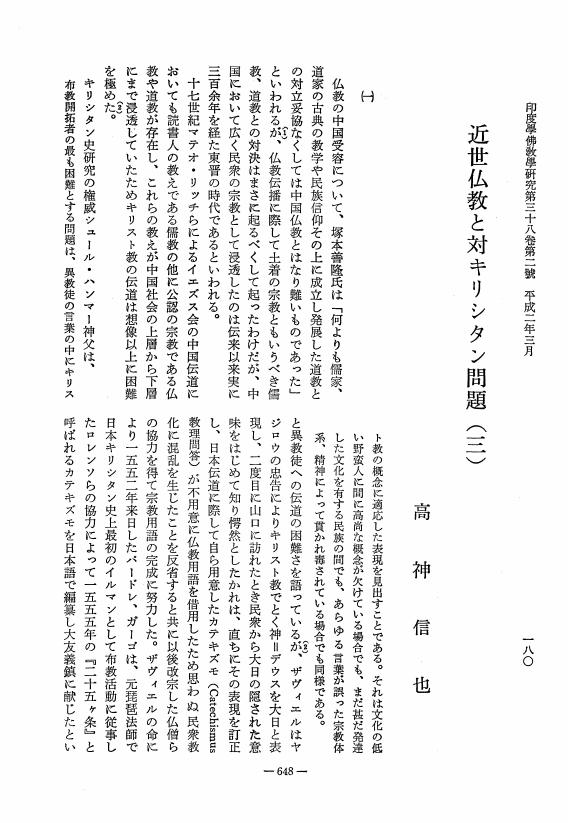2 0 0 0 OA 天台教学における霊山同聴の意義
- 著者
- 神達 知純
- 出版者
- 日本印度学仏教学会
- 雑誌
- 印度學佛教學研究 (ISSN:00194344)
- 巻号頁・発行日
- vol.61, no.1, pp.195-202, 2012-12-20 (Released:2017-09-01)
2 0 0 0 OA vijñanaparinama-『大乗起信論』の背景-
- 著者
- 阿 理生
- 出版者
- Japanese Association of Indian and Buddhist Studies
- 雑誌
- 印度學佛教學研究 (ISSN:00194344)
- 巻号頁・発行日
- vol.52, no.2, pp.805-799, 2004-03-20 (Released:2010-03-09)
2 0 0 0 OA 玄奘三蔵と『西遊記』――孫悟空・猪八戒・沙悟浄のルーツをめぐって――
- 著者
- 吉村 誠
- 出版者
- 日本印度学仏教学会
- 雑誌
- 印度學佛教學研究 (ISSN:00194344)
- 巻号頁・発行日
- vol.69, no.2, pp.686-692, 2021-03-25 (Released:2021-09-06)
- 参考文献数
- 8
Sun Wukong 孫悟空, Zhu Bajie 猪八戒 and Sha Wujing 沙悟浄 were disciples of Sanzang Fashi 三蔵法師 in the Ming dynasty novel The Journey to the West 西遊記. Many mysteries remain regarding their roots. This article points out that some of the real disciples of Xuanzang 玄奘 (602–664) were their models.The model of Sun Wukong can be found in the Gaochang 高昌 native Ma Xuenchi 馬玄智 who delivered Xuanzang’s letter from Khotan 于闐 to Emperor Taizong 太宗 of Chang’an 長安, and in the exotic-looking attendant in Xuanzang’s portrait. The two may be the same person. He became a “monkey practitioner” 猴行者 in the Song dynasty novel The Narrative Story of Acquisition of Sūtras by Sanzang of the Great Tang Dynasty 大唐三蔵取経詩話 and a monkey-faced attendant in the painting of Acquisition of Sūtras by the Tang Monk 唐僧取経図 found in the Anxi Yulin Grottoes 安西楡林窟 during the same period.The model of Zhu Bajie is considered to be Xuanzang’s disciple Kuiji 窺基 (632–682). According to the Song Biographies of Eminent Monks 宋高僧伝, he traveled with women and food in carriages and was called the “Three Carriages Monk” 三車和尚. Given his image of greed and amorousness, he was fused with a boar (or pig) pulling the chariot of Marīcī 摩利支天 in The Journey to the West of the Yuan Dynasty 元本西遊記. In The Journey to the West, critical Edition by Yang Donglai 楊東来先生批評西遊記 of the Ming dynasty, he calls himself “General Carriage” 御車将軍, a subordinate of Marīcī.The model for Sha Wujing is the Great God 大神 dreamed by Xuanzang, when he was in distress in the desert. He was called “Shensha God” 深沙神 in the Song Dynasty novel The Narrative Story of Acquisition of Sūtras by Sanzang of the Great Tang Dynasty, but in The Journey to the West of the Yuan Dynasty he came to be known as “Sha Monk” 沙和尚. His level of divinity was demoted from god to monk because of the appearance of Zhu Bajie, which was modeled after Kuiji, and the image of Wŏnch’uk 円測 (613–696), a rival of Kuiji was superimposed.
2 0 0 0 OA 親鸞における本願他力思想について
- 著者
- 山崎 龍明
- 出版者
- Japanese Association of Indian and Buddhist Studies
- 雑誌
- 印度學佛教學研究 (ISSN:00194344)
- 巻号頁・発行日
- vol.48, no.2, pp.702-707, 2000-03-20 (Released:2010-03-09)
2 0 0 0 OA 修験者の医療について
- 著者
- 根井 浄
- 出版者
- Japanese Association of Indian and Buddhist Studies
- 雑誌
- 印度學佛教學研究 (ISSN:00194344)
- 巻号頁・発行日
- vol.24, no.2, pp.893-896, 1976-03-31 (Released:2010-03-09)
2 0 0 0 OA 大理国時代の密教文献『諸仏菩薩金剛等啓請次第』に収録される「般若心経法」について
- 著者
- 川崎 一洋
- 出版者
- 日本印度学仏教学会
- 雑誌
- 印度學佛教學研究 (ISSN:00194344)
- 巻号頁・発行日
- vol.57, no.1, pp.93-98, 2008-12-20 (Released:2017-09-01)
2 0 0 0 OA 僧堂修行における規則と罰則
- 著者
- 尾崎 正善
- 出版者
- Japanese Association of Indian and Buddhist Studies
- 雑誌
- 印度學佛教學研究 (ISSN:00194344)
- 巻号頁・発行日
- vol.52, no.1, pp.156-161, 2003-12-20 (Released:2010-03-09)
- 参考文献数
- 6
2 0 0 0 OA 禅宗相伝書における中世神道説の受容と展開 ――三種神器・伊勢二字を中心に――
- 著者
- 広瀬 良文
- 出版者
- 日本印度学仏教学会
- 雑誌
- 印度學佛教學研究 (ISSN:00194344)
- 巻号頁・発行日
- vol.60, no.2, pp.678-681, 2012-03-20 (Released:2017-09-01)
2 0 0 0 OA 「事事無礙」を説いたのは誰か
- 著者
- 石井 公成
- 出版者
- Japanese Association of Indian and Buddhist Studies
- 雑誌
- 印度學佛教學研究 (ISSN:00194344)
- 巻号頁・発行日
- vol.44, no.2, pp.583-588, 1996-03-20 (Released:2010-03-09)
2 0 0 0 OA 宮沢賢治の作品に現れた法華思想
- 著者
- 趙 明烈
- 出版者
- Japanese Association of Indian and Buddhist Studies
- 雑誌
- 印度學佛教學研究 (ISSN:00194344)
- 巻号頁・発行日
- vol.51, no.2, pp.952-948, 2003-03-20 (Released:2010-03-09)
- 参考文献数
- 6
2 0 0 0 OA 農水相を務めた禅僧・広川弘禅
- 著者
- 栗本 眞好
- 出版者
- 日本印度学仏教学会
- 雑誌
- 印度學佛教學研究 (ISSN:00194344)
- 巻号頁・発行日
- vol.70, no.2, pp.712-715, 2022-03-23 (Released:2022-09-09)
- 参考文献数
- 5
Hirokawa Kōzen広川弘禅 (1902-1967), who served as Minister of Agriculture and Fisheries under Prime Minister Shigeru Yoshida 吉田茂 (1878-1967) during the chaotic period after the war, was born as a successor to Ryūsawa Temple竜沢寺, a Sōtō establishment in Fukushima Prefecture, and studied at the current Setagaya Gakuen High School and Komazawa University. I approach him not only as a parliamentary politician, but also as a Zen priest.I pay attention to such things as his attendance, in 1956, along with Kusaba Ryūen草葉隆円 (1895-1966) and Andō Kaku安藤覚 (1899-1967), at the “Buddha’s 2500th Anniversary Celebration” held in Thailand, his installation on the roof of the Aoba Gakuen of a relic of the Buddha during his time as director of the school, and his activities as a Zen priest.In 1952, in the magazine Bungei Shunjū 文芸春秋, he was interviewed by Otis Cary in an article entitled “Monster named Hirokawa Kōzen” (広川弘禅という怪物) in which he is quoted as saying, “Japanese culture is nothing except Buddhist culture. 97% of the national treasures are related to Buddhism. … Japan’s democracy has been clear since the period of the Buddhist articulation that discrimination is equality and equality discrimination差別即平等, 平等即差別.” Concerning the Sekai Bukkyōto kaigi 世界仏教徒会議, he said, “To tell the truth, you must do it in Sanskrit or Pāli; It’s stupid to do it in English.”I would like to pursue Kōzen’s appearance as a Zen priest from the testimonies of people who interacted with him during his lifetime.
2 0 0 0 OA 空觀の記號論理學的解明
- 著者
- 中村 元
- 出版者
- Japanese Association of Indian and Buddhist Studies
- 雑誌
- 印度學佛教學研究 (ISSN:00194344)
- 巻号頁・発行日
- vol.3, no.1, pp.223-231, 1954-09-25 (Released:2010-03-09)
- 被引用文献数
- 1
2 0 0 0 OA 古代インド神話解釈の試み -古代インドのトリックスター論覚え書き-
- 著者
- 松濤 誠達
- 出版者
- Japanese Association of Indian and Buddhist Studies
- 雑誌
- 印度學佛教學研究 (ISSN:00194344)
- 巻号頁・発行日
- vol.24, no.2, pp.557-561, 1976-03-31 (Released:2010-03-09)
2 0 0 0 梵字袈裟曼荼羅の研究
- 著者
- 齋藤 彦松
- 出版者
- 日本印度学仏教学会
- 雑誌
- 印度學佛教學研究 (ISSN:00194344)
- 巻号頁・発行日
- vol.10, no.2, pp.524-525, 1962
2 0 0 0 相違決定の極小モデル
- 著者
- 上田 昇
- 出版者
- 日本印度学仏教学会
- 雑誌
- 印度學佛教學研究 (ISSN:00194344)
- 巻号頁・発行日
- vol.56, no.3, pp.1136-1144, 2008
ディグナーガの因の三相による論理学には相違決定(viruddhavyabhicarin)の現象が見られる.この現象について学者(古代,現代)は様々に説明するが,本稿は,これが特定の思想的立場に基づく論証に生ずる現象ではなく,因の三相による論証自体に内在する問題であることを明確にする.そのため,本稿は,因の三相の論理学を純粋に形式的な観点から見て,相違決定となるための必要条件を求めた上で,相違決定の極小例を提示し,相違決定の「発生現場」を捉える.相違決定の必要条件はまず喩体(遍充関係)に基づいて求められる.続いて,因の第二,三相の各々が喩体を論理的に含意することを証明する.第三相が喩体を含意することは基本的にJ.F.Staalのかつての証明に譲るが,第二相が喩体を含意すること-Staalが証明を試みたが,成功していない-の証明は新たに行う.また本稿は,因明で謂うところの「因同品」「宗同品」の概念を用いて第二相を定式化することによっても喩体が導出できることを示す.相違決定は喩体とは直接のかかわりはない.しかし,因の第二相・第三相が喩体を(論理的に)含意していることが上のようにして示されるから,喩体を基礎として得られた相違決定の必要条件は因の三相を推論の基礎としたときの相違決定の必要条件と考えてよい.従って,第二相・第三相,喩体のいずれを推論の基礎とするかに拘らず,本稿で得られた相違決定の必要条件は成り立つ.
2 0 0 0 OA 原坦山と「印度哲学」の誕生-近代日本仏教史の一断面-
- 著者
- 木村 清孝
- 出版者
- JAPANESE ASSOCIATION OF INDIAN AND BUDDHIST STUDIES
- 雑誌
- 印度學佛教學研究 (ISSN:00194344)
- 巻号頁・発行日
- vol.49, no.2, pp.533-541, 2001-03-20 (Released:2010-03-09)
- 著者
- 細田 典明
- 出版者
- Japanese Association of Indian and Buddhist Studies
- 雑誌
- 印度學佛教學研究 (ISSN:00194344)
- 巻号頁・発行日
- vol.45, no.2, pp.951-943, 1997-03-20 (Released:2010-03-09)
2 0 0 0 OA 鎮源『法華験記』の持経者像 ――常不軽菩薩と基燈法師――
- 著者
- 岡田 文弘
- 出版者
- 日本印度学仏教学会
- 雑誌
- 印度學佛教學研究 (ISSN:00194344)
- 巻号頁・発行日
- vol.63, no.2, pp.680-683, 2015-03-20 (Released:2017-09-01)
2 0 0 0 OA 近世仏教と対キリシタン問題 (三)
- 著者
- 高神 信也
- 出版者
- Japanese Association of Indian and Buddhist Studies
- 雑誌
- 印度學佛教學研究 (ISSN:00194344)
- 巻号頁・発行日
- vol.38, no.2, pp.648-654, 1990-03-20 (Released:2010-03-09)
2 0 0 0 OA 白隠禅の武芸への影響
- 著者
- 笠井 哲
- 出版者
- Japanese Association of Indian and Buddhist Studies
- 雑誌
- 印度學佛教學研究 (ISSN:00194344)
- 巻号頁・発行日
- vol.43, no.1, pp.180-183, 1994-12-20 (Released:2010-03-09)









